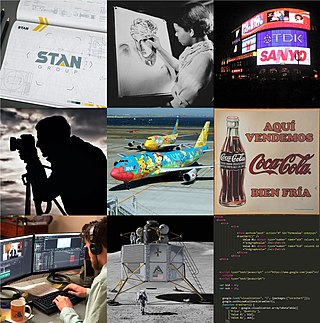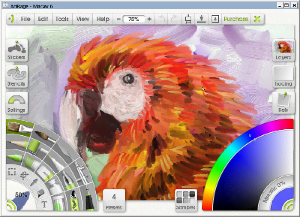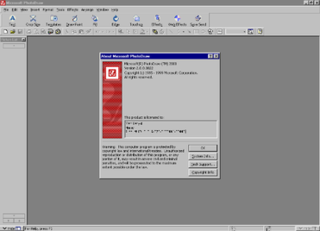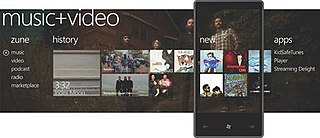Related Research Articles

Graphic design is a profession, academic discipline and applied art whose activity consists in projecting visual communications intended to transmit specific messages to social groups, with specific objectives. Graphic design is an interdisciplinary branch of design and of the fine arts. Its practice involves creativity, innovation and lateral thinking using manual or digital tools, where it is usual to use text and graphics to communicate visually.

The history of the graphical user interface, understood as the use of graphic icons and a pointing device to control a computer, covers a five-decade span of incremental refinements, built on some constant core principles. Several vendors have created their own windowing systems based on independent code, but with basic elements in common that define the WIMP "window, icon, menu and pointing device" paradigm.

Verdana is a humanist sans-serif typeface designed by Matthew Carter for Microsoft Corporation, with hand-hinting done by Thomas Rickner, then at Monotype. Demand for such a typeface was recognized by Virginia Howlett of Microsoft's typography group and commissioned by Steve Ballmer. The name "Verdana" is derived from "verdant" (green) and "Ana".
Adobe Illustrator is a vector graphics editor and design program developed and marketed by Adobe Inc. Originally designed for the Apple Macintosh, development of Adobe Illustrator began in 1985. Along with Creative Cloud, Illustrator CC was released. The latest version, Illustrator 2024, was released on October 10, 2023, and is the 28th generation in the product line. Adobe Illustrator was reviewed as the best vector graphics editing program in 2021 by PC Magazine.
The Visual Component Library (VCL) is a visual component-based object-oriented framework for developing the user interface of Microsoft Windows applications. It is written in Object Pascal.
In computing, an icon is a pictogram or ideogram displayed on a computer screen in order to help the user navigate a computer system. The icon itself is a quickly comprehensible symbol of a software tool, function, or a data file, accessible on the system and is more like a traffic sign than a detailed illustration of the actual entity it represents. It can serve as an electronic hyperlink or file shortcut to access the program or data. The user can activate an icon using a mouse, pointer, finger, or voice commands. Their placement on the screen, also in relation to other icons, may provide further information to the user about their usage. In activating an icon, the user can move directly into and out of the identified function without knowing anything further about the location or requirements of the file or code.
A design language or design vocabulary is an overarching scheme or style that guides the design of a complement of products or architectural settings, creating a coherent design system for styling.

Susan Kare is an American artist and graphic designer, who contributed interface elements and typefaces for the first Apple Macintosh personal computer from 1983 to 1986. She was employee #10 and Creative Director at NeXT, the company formed by Steve Jobs after he left Apple in 1985. She was a design consultant for Microsoft, IBM, Sony Pictures, Facebook, and Pinterest. As of 2007 Kare was an employee of Niantic Labs. As a pioneer of pixel art and of the graphical computer interface, she has been celebrated as one of the most significant designers of modern technology.

Alan Cooper is an American software designer and programmer. Widely recognized as the "Father of Visual Basic", Cooper is also known for his books About Face: The Essentials of Interaction Design and The Inmates Are Running the Asylum: Why High-Tech Products Drive Us Crazy and How to Restore the Sanity. As founder of Cooper, a leading interaction design consultancy, he created the Goal-Directed design methodology and pioneered the use of personas as practical interaction design tools to create high-tech products. On April 28, 2017, Alan was inducted into the Computer History Museum's Hall of Fellows "for his invention of the visual development environment in Visual BASIC, and for his pioneering work in establishing the field of interaction design and its fundamental tools."

ArtRage is a bitmap graphics editor for digital painting created by Ambient Design Ltd. It is currently in version 6, and supports Windows, macOS and mobile Apple and Android devices and is available in multiple languages. It caters to all ages and skill levels, from children to professional artists. ArtRage 5 was announced for January 2017 and finally released in February 2017.
Trident is a proprietary browser engine for the Microsoft Windows version of Internet Explorer, developed by Microsoft.
Icon design is the process of designing a graphic symbol that represents some real, fantasy or abstract motive, entity or action. In the context of software applications, an icon often represents a program, a function, data or a collection of data on a computer system.
Xara is an international software company founded in 1981, with an HQ in Berlin and development office in Hemel Hempstead, UK. It has developed software for a variety of computer platforms, in chronological order: the Acorn Atom, BBC Micro, Z88, Atari ST, Acorn Archimedes, Microsoft Windows, Linux, and more recently web browser-based services.

Microsoft PhotoDraw was a vector graphics and raster image editing software developed by Microsoft. It was released in 1999 as part of the Microsoft Office 2000 family of products and was specifically designed for creating and editing graphics, illustrations, and photo compositions.
A number of vector graphics editors exist for various platforms. Potential users of these editors will make a comparison of vector graphics editors based on factors such as the availability for the user's platform, the software license, the feature set, the merits of the user interface (UI) and the focus of the program. Some programs are more suitable for artistic work while others are better for technical drawings. Another important factor is the application's support of various vector and bitmap image formats for import and export.
Graphic design careers include creative director, art director, art production manager, brand identity developer, illustrator and layout artist.
Ascender Corporation was a digital typeface foundry and software development company located in the Chicago suburb of Elk Grove Village, Illinois in the United States. It was founded in 2004 by a team of software developers, typographers, and font-industry veterans who had previously been involved in developing fonts used widely in computers, inkjet printers, phones, and other digital technology devices. On December 8, 2010, Ascender Corp. was acquired by Monotype Imaging.
Visual Studio is an integrated development environment (IDE) from Microsoft. It is used to develop computer programs including websites, web apps, web services and mobile apps. Visual Studio uses Microsoft software development platforms such as Windows API, Windows Forms, Windows Presentation Foundation, Windows Store and Microsoft Silverlight. It can produce both native code and managed code.

Microsoft Design Language, previously known as Metro, is a design language created by Microsoft. This design language is focused on typography and simplified icons, absence of clutter, increased content to chrome ratio, and basic geometric shapes. Early examples of MDL principles can be found in Encarta 95 and MSN 2.0. The design language evolved in Windows Media Center and Zune and was formally introduced as Metro during the unveiling of Windows Phone 7. It has since been incorporated into several of the company's other products, including the Xbox 360 system software and the Xbox One system software, Windows 8, Windows Phone, and Outlook.com. Before the "Microsoft design language" title became official, Microsoft executive Qi Lu referred to it as the modern UI design language in his MIXX conference keynote speech. According to Microsoft, "Metro" has always been a codename and was never meant as a final product, but news websites attribute this change to trademark issues.
Microsoft Office shared tools are software components that are included in all Microsoft Office products.
References
- "Interview with Virginia Howlett, mother of Verdana" Retrieved September 9, 2005.